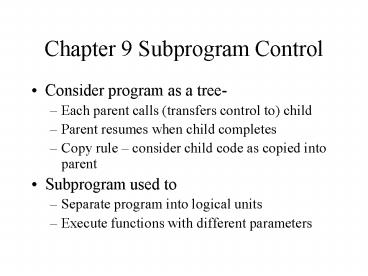Chapter 9 Subprogram Control - PowerPoint PPT Presentation
1 / 15
Title:
Chapter 9 Subprogram Control
Description:
Child is explicitly called (exceptions are not) Entrance at top or elsewhere ... Return address stored in no-op at top of subroutine code ... – PowerPoint PPT presentation
Number of Views:120
Avg rating:3.0/5.0
Title: Chapter 9 Subprogram Control
1
Chapter 9 Subprogram Control
- Consider program as a tree-
- Each parent calls (transfers control to) child
- Parent resumes when child completes
- Copy rule consider child code as copied into
parent - Subprogram used to
- Separate program into logical units
- Execute functions with different parameters
2
Recursion
- Must maintain storage for multiple copies of data
- Code is reentrant stored separately
- Storage for return address and data
- Indirect recursion
- We do not know the number of times that our code
or data will be copied - PL/1 specific statement is recursive
- Non-recursive subprogram does not need stack
implementation
3
Execution structure
- Child is explicitly called (exceptions are not)
- Entrance at top or elsewhere
- FORTRAN, coroutines (resume)
- Scheduled subprogram call can delay transfer of
control - Coroutines have multiple activation records
active at one time but single thread of control
their execution can be traced - Tasks have multiple activation records active at
one time and conceptually allow multiple threads
of control
4
Implementation of non-recursive routines
- For execution efficiency
- Code and data may be joined, with code directly
referencing data address - Return address stored in no-op at top of
subroutine code - Last statement of subroutine is branch to first
address, indirectly - For reliability, may require that code be stored
separately (non self modifying code) - Cost in storage of all (but smaller) activation
records during programs lifetime
5
Implementation for recursive routines
- Activation records (frames) on stack contain
- Callers return address (next CIP)
- Parameters
- Local variables
- Return value for functions and temps
- Ptr to parent activation record (static chain
ptr) - Ptr to callers activation record (dynamic chain
ptr) - Register contains PC (Current Instruction Ptr)
- Register contains base address of activation
record (current environment pointer) - Register contains stack pointer
6
Storage map in general
- System and program code
- Static variables
- Activation records grow dynamically
- --- available storage ----
- Heap storage
- Note deallocation of stack storage when module
completes
7
Pascal forward declaration
- Module can generally call each other (indirect
recursion) if signature (prototype) is known to
them - Pascal uses forward declaration
- P. 356 10 out of 13 compilers handled a
conforming program incorrectly
8
Binding of name to data object
- Reference environment for a module includes
local, nonlocal and global declarations - Static or dynamic binding of name to data object
- Scope of a declaration is the reference
environment in which that declaration is valid - Scope is static if compiler can determine the
declarations reference environment (containing
module) - Static scope associated with block structured
programming
9
Aliases
- Two names for the same data object in the (at
least overlapping) same referencing environment - Ex global variable passed as reference parameter
with different name in subroutine
10
Implementation
- Static scope- compiler stores in code segment the
address of the names data object, if known, else
the offset from the appropriate modules
activation record plus the degree of nesting of
that module to follow the static chain) - Activation record will store values of local data
objects but also a static chain ptr - Dynamic scope either search for the name
through the dynamic chain (implies that names are
stored on activation record) or update a central
name table
11
Retention and deletion of environments
- Are modules history sensitive. Should they be?
- Static variables are retained
- Automatic variables are deleted
- Heap data objects are retained until explicitly
destroyed or garbage is collected, but external
access paths may be lost from the stack - Parameters association should be deleted between
calls - Initial assignment of values to static variables
12
Parameter transmission
- Association of actual and formal parameter
- Positional correspondence
- Named correspondence
- Type checking
- Methods for transmission
- Does program specify implementation?
- Call by reference (var I)
- Call by value or copy (C default)
- Call by value-result (copy in/copy out)
- Call by name (text substitution)
- Call by result (function return)
- Does program specify semantics
- Adas in/out compared with Cs const
13
Example (p. 383)
- Q (int i, int j)
- i i 10 j j 10
- printf ()
- P()
- int a 2 int b 3
- Q( a, b)
- printf ()
- try Q(a, a) also for value/result
- Discuss Q( ab, b) if reference or value/result
is used - Call by name
14
Example (p. 387)
- R( int i, int j)
- i i 1
- j j 1
- P()
- int c4 6,7,8, 0
- int m 2
- R (m, cm)
- Print all of c
15
Exception handling (from chapt 11)
- User defined
- Bad_Data_Value exception
- exception
- when Bad_Data_Value gt
- when others gt
- end //block
- p.438
- Exception propagation dynamic chain































